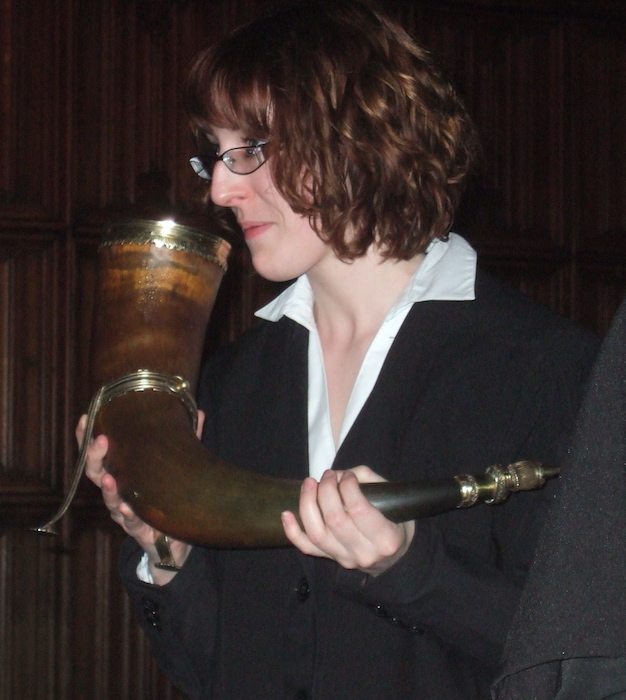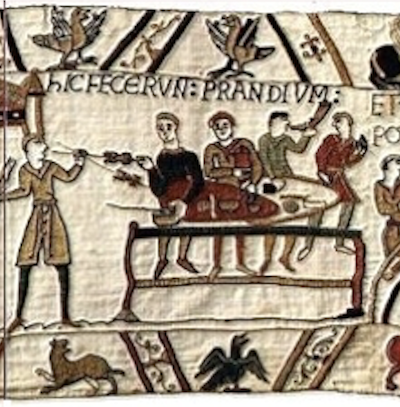Exeter Riddle 14
MEGANCAVELL
Date: Mon 28 Oct 2013Matching Commentaries: Commentary for Exeter Riddle 14
Ic wæs wæpenwiga. Nu mec wlonc þeceð
geong hagostealdmon golde ond sylfore,
woum wirbogum. Hwilum weras cyssað,
hwilum ic to hilde hleoþre bonne
5 wilgehleþan, hwilum wycg byreþ
mec ofer mearce, hwilum merehengest
fereð ofer flodas frætwum beorhtne,
hwilum mægða sum minne gefylleð
bosm beaghroden; hwilum ic bordum sceal,
10 heard, heafodleas, behlyþed licgan,
hwilum hongige hyrstum frætwed,
wlitig on wage, þær weras drincað,
freolic fyrdsceorp. Hwilum folcwigan
on wicge wegað, þonne ic winde sceal
15 sincfag swelgan of sumes bosme;
hwilum ic gereordum rincas laðige
wlonce to wine; hwilum wraþum sceal
stefne minre forstolen hreddan,
flyman feondsceaþan. Frige hwæt ic hatte.
I was an armed warrior. Now a bold
young retainer covers me with gold and silver,
twisted coils of wire. Sometimes men kiss me,
sometimes I call close comrades
5 to battle with my voice, sometimes a horse bears me
over the bounds, sometimes a sea-steed
draws me over the depths, brightly decorated,
sometimes one of the girls fills
my bosom, ring-adorned; sometimes I must lie
10 on boards, hard, headless, despoiled,
sometimes I hang decorated with ornaments,
appealing on the wall, where men drink,
comely army-attire. Sometimes battle-warriors
carry me on a horse, when I must swallow,
15 treasure-stained, breath from a certain one’s breast;
sometimes I proudly call with cries
warriors to their wine; sometimes I have to reclaim
stolen goods from enemies with my voice,
put to flight fiendish foes. Reveal what I am called.
Notes:
This riddle appears on folio 104r of The Exeter Book.
The above Old English text is based on this edition: Elliott van Kirk Dobbie and George Philip Krapp, eds, The Exeter Book, Anglo-Saxon Poetic Records 3 (New York: Columbia University Press, 1936), page 187.
Note that this edition numbers the text Riddle 12: Craig Williamson, ed., The Old English Riddles of the Exeter Book (Chapel Hill: University of North Carolina Press, 1977), page 75.
Tags: anglo saxon exeter book riddles old english solutions riddle 14
Related Posts:
Exeter Riddle 3
Exeter Riddle 20
Exeter Riddle 63


Commentary for Exeter Riddle 13
MATTHIASAMMON
Date: Tue 08 Oct 2013Matching Riddle: Exeter Riddle 13
Having moved into the realm of four-footed animals with Riddle 12, we now leave the oxen to plough his lone furrow and return – supposedly – to the realm of birds. That being said, we immediately encounter the riddle’s first paradox: both the first and last half line refer to the riddle object’s ability to walk or tread (tredan) on the ground (turf and lond). However, some of the motifs used in this riddle may be familiar by now: the feorg cwico (living spirit) mentioned in line 3 takes us back to Riddles 9, 10 and 12 and strongly suggests that we are dealing with an animal. The hrægl of line 9 recalls the swan’s feathers being described by the same term back in Riddle 7. And thus, the argument goes, we are dealing with a kind of bird. At the centre of the riddle is again the transformation that this creature undergoes, when it is awoken through God’s might and gains its living spirit. However, the riddler wants us to puzzle over a more serious paradox: what kind of creature lives, walks and eats even though its skin is hanging on the wall? And who are the six brothers and four sisters of the first two lines?
Early solutions to this riddle focused on the transformation aspect and suggested, for example, a caterpillar which metamorphoses into a butterfly. But I’m sure you’ll agree that this does not really cover all the clues the riddle gives us. A more metaphorical solution was that of ten fingers in a glove (which accounts for the numerological clue and gloves were made out of a fell or skin, but the second part of the riddle doesn’t really fit the metaphor). It was the German scholar Moritz Trautmann who first hit upon the solution of "chick" or "chicken." This quickly gained general acceptance as it matches something we know from the real world: in this reading, the "skin on the wall" is the membrane on the inside of the egg that a newly-hatched chick leaves behind, its "renewed" garment is its new down. Furthermore, the idea of the chick shedding its skin as its distinctive aspect seems to have been part of a wider riddle tradition. There are several Latin riddles that play on this phenomenon; in fact most of them are boiled down (the pun is courtesy of Martha Bayless, who edited one of these Latin riddles) to a couple of lines or so but they all mention the shedding of the skin. On the other hand, one of our readers, Linden Currie, suggests that the "skin hanging on the wall" may in fact refer to the caul of a new-born calf which was used in early medieval Iceland to cover the window-holes in houses when stretched over a frame and made translucent to let light in. Might we not imagine something similar for early medieval England? Such an object, Linden argues, could easily be described as sweotol in the sense of "transparent" as well as "visible" (gesyne). And would the description of something "treading the ground" not fit a calf better than a chicken? Such a solution would also yoke (or yolk?) this riddle to its predecessor.*
At any rate, I hear you cry, what of the six brothers and four sisters? Back in 1950, Erika von Erhardt-Siebold hit on an ingenious solution to this part: she suggested that the answer to the riddle in Old English is ten ciccenu or "ten chickens." Now count the number of consonants and vowels in this phrase and what do you get? Six…and four! Brilliant! Only…the word ciccenu doesn’t really exist in Old English, at least in the texts we have. The standard Old English (or West Saxon) version of this word would be cicenu which ruins our nice solution (and it should really be tien, but we won’t mention that). But we can’t rule out that this is a possible Northern spelling, and nobody has really come up with a better solution – the most recent commentators also accept it, though Patrick Murphy is slightly unhappy with the fact that the "ten" of the answer refers both to the number of chickens in the solution and to the letters in the "name" of the solution (though this is again not unknown in medieval riddle tradition in general).
Ten chickens! What are the chances of finding a photo with the right number? Image from Wikimedia Commons (licence: CC BY-SA 4.0).
Murphy has also pointed out that this riddle may evoke other associations: some creatures who lose their garments, are "awoken" by their creator and have to walk the earth and are forced to eat what they can get through their own toil? I hope you’ve realised this is of course the story of Adam and Eve being cast out of Eden. Murphy finds some parallels between the language of this riddle and Old English poetic versions of the Edenic story. Somebody who focuses on this allusive metaphorical reading might come up with the solution Adam ond Eue – and if we count the consonants and vowels there…I assume you can guess what the answer is. Murphy is not necessarily disputing the accepted solution but it is a reminder that it is worth keeping in mind that riddles can work on several levels.
By the way, despite all this work, there are some bits in the riddle that have so far defied solution, in particular the haswe blede of line 9. Both of these words have a range of meanings – if we look at the work of previous translators and commentators, the average meaning is something like "grey(ish) fruit," though nobody has been able to come up with a convincing explanation beyond "the stuff that new-born chicks eat" – which, like greyish fruit, is slightly unsatisfying. Any thoughts on this (and anything else) would be welcome in the comments!
Not wishing to overegg the pudding, I have chickened out of giving you the full arguments, but if you want to brood on it a bit more, here are some references you can follow up on:
References and Suggested Reading:
Bitterli, Dieter. Say What I am Called: The Old English Riddles of the Exeter Book and the Anglo-Latin Riddle Tradition. Toronto: University of Toronto Press, 2009, pages 115-21.
Murphy, Patrick J. Unriddling the Exeter Riddles. University Park, PA: Pennsylvania State University Press, 2011, pages 53-60 and 91-95.
von Erhardt-Siebold, Erika. “Old English Riddle 13.” Modern Language Notes, vol. 65 (1950), pages 97-100.
Williamson, Craig, ed., The Old English Riddles of the Exeter Book. Chapel Hill, NC: University of North Carolina Press, 1977, pages 168-70.
*If you want to know more details, Linden can be contacted under linden.currie(at)gmail.com.
Tags: anglo saxon exeter book riddles old english solutions riddle 13
Related Posts:
Commentary for Exeter Riddle 7
Commentary for Exeter Riddle 9
Commentary for Exeter Riddle 10
Commentary for Exeter Riddle 12
Exeter Riddle 13